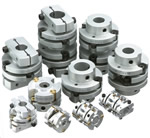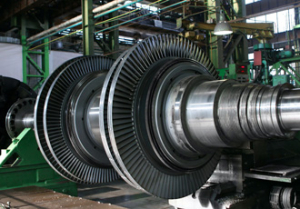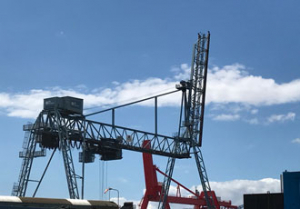Selecting the Ideal Coupling
26th March 2013
Source:
Huco DynaTork

Flexible shaft couplings connect two shafts, end to end. They transmit rotation from one to the other and accommodate the slight, unintentional misalignment that is always present when two independently mounted shafts are presented for connection. There are many kinds of flexible couplings and while they all fulfil their primary purpose, each has certain characteristics that make it more effective in one application than another.
Misalignment compensation and axial motion
The choice of couplings available to today’s engineers can be daunting but one of the first factors that must be considered in determining the best for the job is whether the type concerned can provide adequate misalignment protection. The particular mechanism used – bellows, membrane, flexible beam or sliding disc – determines the performance characteristic of the coupling including its tolerance of misalignment or axial motion.
For instance, sliding disc and universal/lateral couplings can tolerate large misalignments but at the cost of having their backlash-free life reduced. Bellows-type couplings can absorb a high degree of axial motion with a possible reduction in misalignment capacity. Membrane couplings, however, can be damaged beyond repair if axial motion exceeds the coupling’s specification. That said, they can withstand large misalignments with little or no reduction in life expectancy.
Where misalignment is incidental, in other words, caused simply by manufacturing tolerances, a more realistic measure is the effective radial error. This is the radial distance between the shafts’ axes measured midway along the length of the coupling. Sometimes called the composite error, this can be crucial when determining a value for the maximum permissible misalignment.
Axial motion is often created as a result of axial clearances in the shaft bearings, or through thermal expansion. While it is usual to absorb this with a suitable coupling, it may, in some cases, be more beneficial to resist the motion, particularly if it has a positioning function. Couplings such as the universal/lateral type can be useful in such circumstances.
Flexible couplings are designed to protect shaft support bearings from destructive radial and thrust loads arising from misalignment and axial motion. In effect, all couplings resist these properties, therefore the conclusion is that those with least resistance will better protect the bearings.
Load torque, inertia and torsional stiffness
In applications where couplings are used to drive frictional loads - for example, pumps, shutter doors and machinery - the coupling’s torsional stiffness is not a major factor as the angular synchronisation of the shafts is not an issue. However, when resonance is a problem, it is possible to reduce the coupling’s torsional stiffness and avoid conflict with the natural resonance of the machine.
This does not apply when the loads are inertial; typically positioning and velocity control systems where registration of input and output shafts is critical throughout the operating cycle.
In these applications the three elements of motor, coupling and load combine to create a resonant system. The frequency of the system is controlled by the load inertia and the coupling’s torsional stiffness. Increasing the inertia, or lowering the torsional stiffness, results in a lower resonant frequency.
In order to control a resonant system you must work well below its resonant frequency. For example, imagine supporting a weight on an elastic band. You can control the weight’s vertical movement if you move your hand slowly. Increase the speed and the weight barely moves.
Therefore, to improve responsiveness you require less elasticity or you need to reduce the weight. If you now substitute the elastic band with a coupling and the weight with an inertial load, you have an analogy of an inertial system.
To summarise, when the emphasis is on performance, you require a stiffer coupling in order to reduce setting times, improve positional accuracy and raise the upper limit of dynamic performance.
GUIDELINES FOR COUPLING SELECTION
Does the coupling provide adequate misalignment protection? Can it transmit the load torque?
• Do I need axial motion or axial stiffness?
• Can it sustain the required speed of rotation?
• Will it fit within the available space envelope?
• Can it operate at the designated ambient temperature
• Does it provide the torsional stiffness required for positional accuracy?
• Does it provide electrical isolation between the shafts?
• Will it have the required life expectancy?
The choice of couplings available to today’s engineers can be daunting but one of the first factors that must be considered in determining the best for the job is whether the type concerned can provide adequate misalignment protection. The particular mechanism used – bellows, membrane, flexible beam or sliding disc – determines the performance characteristic of the coupling including its tolerance of misalignment or axial motion.
For instance, sliding disc and universal/lateral couplings can tolerate large misalignments but at the cost of having their backlash-free life reduced. Bellows-type couplings can absorb a high degree of axial motion with a possible reduction in misalignment capacity. Membrane couplings, however, can be damaged beyond repair if axial motion exceeds the coupling’s specification. That said, they can withstand large misalignments with little or no reduction in life expectancy.
Where misalignment is incidental, in other words, caused simply by manufacturing tolerances, a more realistic measure is the effective radial error. This is the radial distance between the shafts’ axes measured midway along the length of the coupling. Sometimes called the composite error, this can be crucial when determining a value for the maximum permissible misalignment.
Axial motion is often created as a result of axial clearances in the shaft bearings, or through thermal expansion. While it is usual to absorb this with a suitable coupling, it may, in some cases, be more beneficial to resist the motion, particularly if it has a positioning function. Couplings such as the universal/lateral type can be useful in such circumstances.
Flexible couplings are designed to protect shaft support bearings from destructive radial and thrust loads arising from misalignment and axial motion. In effect, all couplings resist these properties, therefore the conclusion is that those with least resistance will better protect the bearings.
Load torque, inertia and torsional stiffness
In applications where couplings are used to drive frictional loads - for example, pumps, shutter doors and machinery - the coupling’s torsional stiffness is not a major factor as the angular synchronisation of the shafts is not an issue. However, when resonance is a problem, it is possible to reduce the coupling’s torsional stiffness and avoid conflict with the natural resonance of the machine.
This does not apply when the loads are inertial; typically positioning and velocity control systems where registration of input and output shafts is critical throughout the operating cycle.
In these applications the three elements of motor, coupling and load combine to create a resonant system. The frequency of the system is controlled by the load inertia and the coupling’s torsional stiffness. Increasing the inertia, or lowering the torsional stiffness, results in a lower resonant frequency.
In order to control a resonant system you must work well below its resonant frequency. For example, imagine supporting a weight on an elastic band. You can control the weight’s vertical movement if you move your hand slowly. Increase the speed and the weight barely moves.
Therefore, to improve responsiveness you require less elasticity or you need to reduce the weight. If you now substitute the elastic band with a coupling and the weight with an inertial load, you have an analogy of an inertial system.
To summarise, when the emphasis is on performance, you require a stiffer coupling in order to reduce setting times, improve positional accuracy and raise the upper limit of dynamic performance.
GUIDELINES FOR COUPLING SELECTION
Does the coupling provide adequate misalignment protection? Can it transmit the load torque?
• Do I need axial motion or axial stiffness?
• Can it sustain the required speed of rotation?
• Will it fit within the available space envelope?
• Can it operate at the designated ambient temperature
• Does it provide the torsional stiffness required for positional accuracy?
• Does it provide electrical isolation between the shafts?
• Will it have the required life expectancy?
Similar articles
More from Huco DynaTork
- Rotary encoders provide precise digital data measurements 14th March 2019
- Air motors are efficient and versatile in hazardous areas 20th December 2016
- Couplings exhibit efficiency in tractor transmission 1st December 2016
- Couplings specified for reliability in forklift industry 11th October 2016
Product Centre Updates
2024 World Battery & Energy Storage Industry Expo (WBE)
8th August 2024
China 1st and 2nd Floor, Area A, China Import and Export Fair Complex

-(1)ed.jpg)










Write a comment
No comments